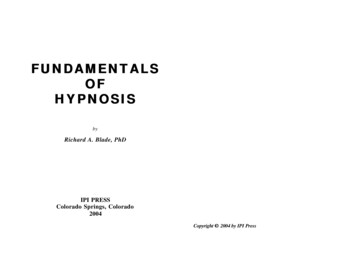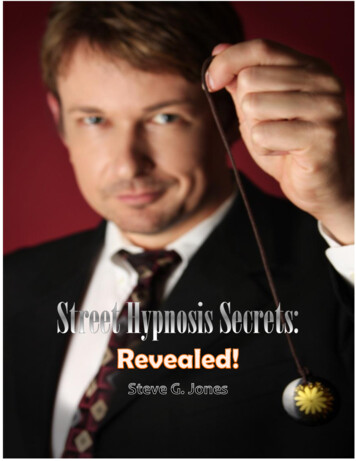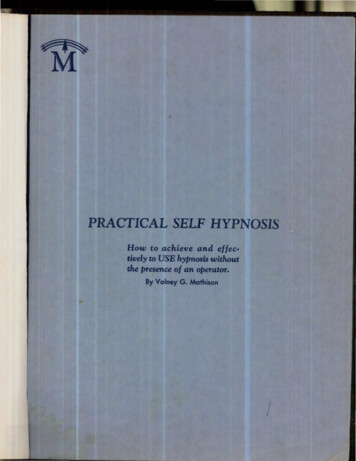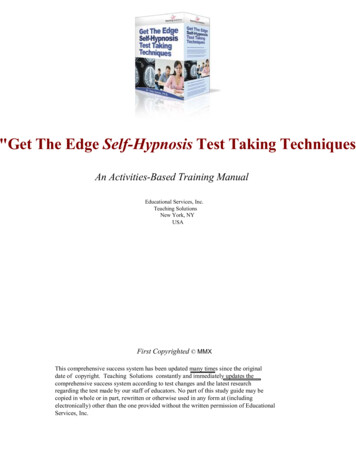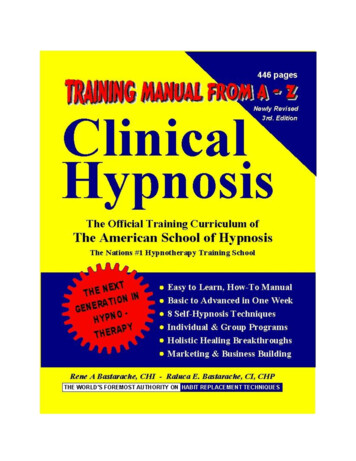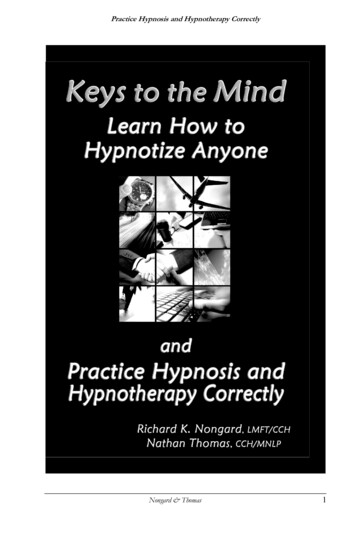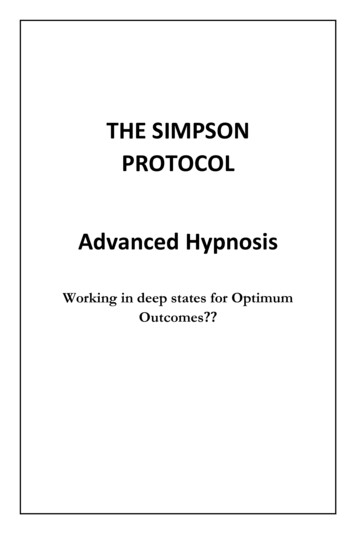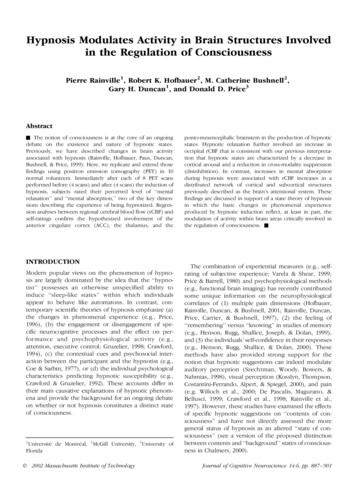
Transcription
Hypnosis Modulates Activity in Brain Structures Involvedin the Regulation of ConsciousnessPierre Rainville 1 , Robert K. Hofbauer 2 , M. Catherine Bushnell2 ,Gary H. Duncan1 , and Donald D. Price3Abstract& The notion of consciousness is at the core of an ongoingdebate on the existence and nature of hypnotic states.Previously, we have described changes in brain activityassociated with hypnosis (Rainville, Hofbauer, Paus, Duncan,Bushnell, & Price, 1999). Here, we replicate and extend thosefindings using positron emission tomography (PET) in 10normal volunteers. Immediately after each of 8 PET scansperformed before (4 scans) and after (4 scans) the induction ofhypnosis, subjects rated their perceived level of ‘‘mentalrelaxation’’ and ‘‘mental absorption,’’ two of the key dimensions describing the experience of being hypnotized. Regression analyses between regional cerebral blood flow (rCBF) andself-ratings confirm the hypothesized involvement of theanterior cingulate cortex (ACC), the thalamus, and theINTRODUCTIONModern popular views on the phenomenon of hypnosis are largely dominated by the idea that the ‘‘hypnotist’’ possesses an otherwise unspecified ability toinduce ‘‘sleep-like states’’ within which individualsappear to behave like automatons. In contrast, contemporary scientific theories of hypnosis emphasize (a)the changes in phenomenal experience (e.g., Price,1996), (b) the engagement or disengagement of specific neurocognitive processes and the effect on performance and psychophysiological activity (e.g.,attention, executive control; Gruzelier, 1998; Crawford,1994), (c) the contextual cues and psychosocial interaction between the participant and the hypnotist (e.g.,Coe & Sarbin, 1977), or (d) the individual psychologicalcharacteristics predicting hypnotic susceptibility (e.g.,Crawford & Gruzelier, 1992). These accounts differ intheir main causative explanations of hypnotic phenomena and provide the background for an ongoing debateon whether or not hypnosis constitutes a distinct stateof consciousness.1Université de Montréal,Florida2McGill University, 2002 Massachusetts Institute of Technology3University ofponto-mesencephalic brainstem in the production of hypnoticstates. Hypnotic relaxation further involved an increase inoccipital rCBF that is consistent with our previous interpretation that hypnotic states are characterized by a decrease incortical arousal and a reduction in cross-modality suppression(disinhibition). In contrast, increases in mental absorptionduring hypnosis were associated with rCBF increases in adistributed network of cortical and subcortical structurespreviously described as the brain’s attentional system. Thesefindings are discussed in support of a state theory of hypnosisin which the basic changes in phenomenal experienceproduced by hypnotic induction reflect, at least in part, themodulation of activity within brain areas critically involved inthe regulation of consciousness. &The combination of experiential measures (e.g., selfrating of subjective experience; Varela & Shear, 1999;Price & Barrell, 1980) and psychophysiological methods(e.g., functional brain imaging) has recently contributedsome unique information on the neurophysiologicalcorrelates of (1) multiple pain dimensions (Hofbauer,Rainville, Duncan, & Bushnell, 2001; Rainville, Duncan,Price, Carrier, & Bushnell, 1997), (2) the feeling of‘‘remembering’’ versus ‘‘knowing’’ in studies of memory(e.g., Henson, Rugg, Shallice, Joseph, & Dolan, 1999),and (3) the individuals’ self-confidence in their responses(e.g., Henson, Rugg, Shallice, & Dolan, 2000). Thesemethods have also provided strong support for thenotion that hypnotic suggestions can indeed modulateauditory perception (Szechtman, Woody, Bowers, &Nahmias, 1998), visual perception (Kosslyn, Thompson,Costantini-Ferrando, Alpert, & Spiegel, 2000), and pain(e.g. Willoch et al., 2000; De Pascalis, Magurano, &Bellusci, 1999; Crawford et al., 1998; Rainville et al.,1997). However, these studies have examined the effectsof specific hypnotic suggestions on ‘‘contents of consciousness’’ and have not directly assessed the moregeneral status of hypnosis as an altered ‘‘state of consciousness’’ (see a version of the proposed distinctionbetween contents and ‘‘background’’ states of consciousness in Chalmers, 2000).Journal of Cognitive Neuroscience 14:6, pp. 887– 901
Hypnotic states may be described most adequately bythe global changes produced in subjective experienceand possibly in self-representation, as these may beessential and ubiquitous to all hypnosis-related phenomena. Studies of hypnosis using experiential analyses haveidentified a series of dimensions that characterize hypnotic states (Price, 1996). These dimensions include: (1)feelings of deep mental relaxation; (2) mental absorption; (3) a diminished tendency to judge, monitor, andcensor; (4) a suspension of usual orientation towardtime, location, and/or sense of self; and (5) the experience of one’s own response as automatic or extravolitional. Notably, those effects are not restricted tospecific sensory modalities or specific ‘‘contents’’ ofconsciousness, and pertain largely to the subjects’ representation, monitoring, and regulation of their ownbody-self and mental state. These alterations in ‘‘selfrepresentation,’’ possibly underlying the changes insubjective experience, provide some support for thenotion that hypnosis is a distinct ‘‘state’’ of consciousness, to the extent that self-representation is likely toplay a key role in basic aspects of consciousness (e.g.,Metzinger, 2000; Damasio, 1999). The identification andexperimental manipulation of these basic dimensions ofexperience using hypnosis may further provide someleverage to investigate the neural correlates of background states of consciousness (see Chalmers, 2000).At least two of the identified experiential dimensions,mental relaxation and mental absorption, can be readilyassociated with specific instructions used to inducehypnosis. Hypnotic relaxation results from direct instructions for relaxation, and suggestions for pleasantbody feelings (e.g., warmth and heaviness), drowsiness,and mental ease. Mental absorption is likely induced bysuggestions for continuous focus on the hypnotist’svoice and on the conveyed instructions, and by suggestions for decreased orientation to, and interest in, otherirrelevant external sources of stimulation and spontaneous thoughts. Consistently, mental absorption hasbeen described as a state of ‘‘total attention that fullyengages one’s representational resources and resultsin imperviousness to distracting events’’ (Tellegen &Atkinson, 1974).In the present study, 10 normal volunteers rated theirlevel of relaxation and mental absorption immediatelyafter each of 8 positron emission tomography (PET)scans performed before (4 scans) and during (4 scans)hypnosis. The subject’s left hand was immersed in eitherwarm or painfully hot water during each scan andthe variance associated with this stimulation factor wasremoved in all regional cerebral blood flow (rCBF)analyses reported here (ANCOVA; pain-related activityis the subject of a separate report; Hofbauer et al., 2001).The reliability of the effects of hypnotic induction onbrain activity is first assessed by comparing the present888Journal of Cognitive Neuroscienceresults with those obtained in our previous study (Rainville, Hofbauer, et al., 1999). The present report furtherexamines the cerebral correlates of hypnotically inducedchanges in the subjective experience of mental relaxationand mental absorption using regression analyses of rCBFon self-ratings. Directed searches are conducted on theanterior cingulate cortex (ACC) and the thalamus because of their suggested involvement in attention, cortical arousal, and self-regulation, and based on previousstudies showing coactivation in these areas following theinduction of hypnosis (Maquet et al., 1999; see Table 1and Appendix in Rainville, Hofbauer, et al., 1999). Thebrainstem is further included as a specific search areabased on the critical implication of brainstem nuclei inthe regulation of conscious states, and on their important interactions with the thalamus and the ACC in theregulation of sleep – wakefulness and attention (e.g.,Aston-Jones, Rajkowski, & Cohen, 1999; Kinomura, Larsson, Gulyas, & Roland, 1996; Steriade & McCarley, 1990).Additional changes in cerebral activity are examinedusing global searches over the entire brain.RESULTSHypnosis-Related Changes in Mental Relaxationand Mental AbsorptionThe induction of hypnosis produced significant increases in self-ratings of both mental relaxation andmental absorption (Figure 1). Likewise, both experiential measures showed modest but significant correlations with a standardized measure of individualhypnotic susceptibility (Stanford Hypnotic SusceptibilityScale—Form A [SHSS-A]; mental relaxation: Spearman’sR .38, p .01; mental absorption: Spearman’sR .27, p .05). These results and additional convergent evidence in the same subjects, or in differentsubjects using the same method, indicate that theprocedure was effective in inducing hypnotic statesNormalized Self-Rating ( SEM)Neurophenomenology of Hypnotic States8.0p 0.001p onFigure 1. Hypnosis-related changes in mental relaxation andabsorption. Self-rated relaxation and absorption (normalized withinsubjects) increased significantly following the induction of hypnosis(see p values).Volume 14, Number 6
(Hofbauer et al., 2001; Rainville et al., 1997; Rainville,Carrier, Hofbauer, Bushnell, & Duncan, 1999; Rainville,Hofbauer, et al., 1999).Heart rate, measured before and during scans, did notchange significantly following the induction of hypnosis(see Hofbauer et al., 2001).Reliability of Hypnosis-Related Changes in rCBFThe reliability of the effects of hypnosis on cerebralactivity was examined by comparing the results of asubtraction analysis (Hypnosis minus Baseline conditions) with those of our previous study (see Table 2 inRainville, Hofbauer, et al., 1999). Our current resultsreplicated the previously reported rCBF increases inboth occipital lobes, the right Sylvian region (peaks inthe inferior frontal and superior temporal gyri), the leftinsula (more anterior and bilateral in the present study),and the right ACC. However, ACC activation was moreextensive here with significant clusters of activatedvoxels covering multiple areas of the ACC and peaksfound in both the right and left hemispheres, inthe middle, rostral, and perigenual ACC. The frontalincreases in rCBF extended further bilaterally in thecentral region, and in the medial frontal and prefrontalareas (superior frontal and orbito-frontal). Decreases inrCBF observed in our previous study were replicated inthe right inferior parietal lobule, the precuneus, and theleft posterior temporal cortices (bilateral here). Theeffects previously reported and not replicated here arethe increases in the right parietal operculum and thedecreases in the medial frontal cortex and the posteriorcingulate gyrus (here, medial parietal decreases werelimited to the precuneus). Occipital increases in rCBFwere again stronger in the warm stimulation condition,and prefrontal increases were stronger in the painfulstimulation condition. These results largely confirm thereliability of the changes in rCBF associated with theinduction of hypnosis.Mental Relaxation- and Absorption-Related EffectsDirected Search over the Brainstem, the Thalamus andthe ACCThe functional role of particular structures thought to beinvolved in the production of hypnosis was assessed byanalyzing the degree of correlation between rCBF inthese regions and subjects’ estimates of the experientialindices of hypnosis (mental relaxation and absorption)(Table 1; Figure 2). Increases in mental relaxation werecorrelated with rCBF decreases in the mesencephalictegmentum of the brainstem (Figure 2A) and withTable 1. Peak t Values Observed in the Directed Search Areas in Regression Analyses on Self-Ratings and Thalamic rCBFRelaxationBrainstemThalamus¡2.67*(¡3, ¡33, cificThalamusCovariation¡2.81*(¡1, ¡38, ¡17)ns 2.78*(1, ¡26, ¡22) 3.12*(13, ¡26, ¡15) 4.45***(¡3, ¡16, 12) 3.50**(17, ¡11, 2)¡3.68**(¡3, ¡16, 12) 2.60*(¡1, ¡18, 12) 2.87*(3, ¡32, ¡24)ACCmidrostralperigenual 2.60*(1, 15, 35)ns 3.02*(5, 34, 9)ns¡3.68**(5, 37, 45a )nsns 3.45**(1, 29, 30) 2.96*(8, 32, 9)ns 4.32**(3, 32, 39a )ns 3.87**(8, 13, 44) 3.82**(1, 43, 32a )nsRegression models were used to evaluate the slope of the relationship between relaxation or absorption ratings and rCBF. Relaxation-specific andabsorption-specific effects were further tested after accounting for variance associated with absorption and relaxation, respectively (see Methods).Thalamic covariations were tested in a regression model evaluating the relationship between rCBF in the thalamus, at the site of absorption-specificactivity, and rCBF in the brainstem, the rest of the thalamus, and the ACC. Stereotaxic coordinates are given for each peak according to the atlas ofTalairach and Tournoux (1988) (x, y, z lateral, anterior, superior).ns no significant peak found (¡2.58 t 2.58; p .01).*p .01; **p .001; ***p .0001 (uncorrected p values).aPeak is over the right medial superior frontal gyrus, within a cluster extending into the ACC at the site of significant absorption-related effect(x, y, z 1, 29, 30).Rainville et al.889
Figure 2. Statistical (t) maps, overlaid on a midsagittal view of a single-subject MRI anatomical image, showing the location of significant positive(red arrows) and negative (blue arrow) regression slopes between rCBF and self-ratings in the three regions of interest (brainstem, thalamus, andACC; see Methods). (A) A negative regression peak is found with relaxation in the mesencephalic tegmentum and (B) positive regression peaksare found in the middle (mACC) and perigenual (pACC) portion of the ACC (note the reversal of the color scale). (C) Positive regression peaksare found with absorption in the thalamus, and in the rostral ACC (rACC) and pACC. (D) The regression of rCBF on absorption ratings, afteraccounting for relaxation-related effects, confirmed the positive regression peaks specific to absorption in the thalamus and rACC. This analysisfurther revealed an additional positive peak in the upper pons. Color scales in C and D are as in B. Stereotaxic coordinates of peaks are reportedin Table 1.increases in the middle and perigenual ACC (Figure 2B).Increases in absorption were correlated with rCBFincreases in the thalamus, and in the rostral and perigenual ACC (Figure 2C).The specificity of any changes in the rCBF associatedwith either mental relaxation (relaxation-specific) orabsorption (absorption-specific) was further examinedusing ANCOVA (see Methods) to remove the varianceshared with the other factor—absorption and relaxation, respectively (Table 1). Relaxation-specific negativecorrelations were found in the brainstem, in the thalamus, and in the superior frontal gyrus in a clusterof significant voxels extending over the rostral ACC.Absorption-specific effects confirmed the significant positive correlation between mental absorption and rCBFin the thalamus and in the rostral ACC and furtherrevealed a significant positive peak in the upper ponsof the brainstem (Figure 2D; Table 1). Although mentalrelaxation and absorption both increased during hypnosis, these results demonstrate that the negative correlation in the mesencephalic brainstem and thethalamus appears to be exclusively associated with890Journal of Cognitive Neurosciencemental relaxation, while the positive correlations inthe upper pons, the thalamus, and the mid-ACC appearto be exclusively associated with mental absorption.Global SearchesResults of the global searches show additional differences between the patterns of activity related to mentalrelaxation and absorption. In the frontal lobe, increasesin prefrontal rCBF were positively correlated primarilywith mental absorption (Table 2), while increases in theprecentral region were positively correlated with bothrelaxation (Figure 3A) and absorption (Table 2). Consistently, after removing the variance shared betweenmental relaxation and absorption, positive absorptionspecific correlations (Table 2; Figure 3B) and negativerelaxation-specific correlations (Table 2) were observedin prefrontal areas, while most precentral effects did notreach significance.Posterior cortical areas displayed a mixed pattern ofresults. Negative correlations observed in both temporallobes were more reliably related to mental relaxationVolume 14, Number 6
than absorption and the relaxation-related effects heldafter accounting for variance in absorption (Table 2—relaxation-specific). Additional sites of relaxation-specificeffects included negative correlations in the right parietal operculum and lobule and positive correlations in theright precuneus, the left inferior parietal lobule, and thebilateral occipital cortices (Table 2—relaxation-specific).The effects associated with absorption in the posterior cortices were strikingly different from the effects ofrelaxation. After accounting for relaxation-related variance, we observed both positive and negative absorption-specific correlations in both the right and leftparietal lobules (see Table 2—absorption-specific). Inthe inferior parietal lobules, positive and negative correlations dominated in the right and left hemispheres,respectively (Figure 3B). Strong negative correlationswere also observed over the right precuneus, theposterior cingulate cortex, and both occipital lobes(Figure 3B).Additional statistical trends directly relevant to ourhypotheses were also observed in the somatosensorycortices where rCBF was negatively correlated with mental relaxation (see Figure 3A; right S1 peak coordinates:44, ¡35, 59, t ¡2.86, p-uncorrected .014, clusterp .06; left S1: ¡44, ¡21, 16, t ¡2.51, p-uncorrected .026, cluster analysis, p .10; right parietal operculum,S2: 48, ¡21, 24, t ¡3.51, p-uncorrected .003, clusterp .10; right posterior insula: 44, ¡4, 15, t ¡2.96,p-uncorrected .011, cluster p .10).Covariations with Thalamic rCBFIn our previous study, thalamic activity was found tobe correlated with hypnosis-related ACC activity (seeTable 2 and Appendix in Rainville, Hofbauer, et al.,1999) and several studies suggest a pivotal role of thethalamus in arousal, attention, and consciousness, andin the interaction between the brainstem and the ACC(e.g., Paus et al., 1997; Paus, 2001; Portas, Howseman,Josephs, Turner, & Frith, 1998; Hofle et al., 1997). Here,we tested the association between absorption-relatedactivity in the thalamus and activity in other sites ofabsorption-related changes using a covariation analysiscentered on the absorption-specific peak in the thalamus reported in Table 1. Absorption-specific sites in thebrainstem (upper pons) and the ACC showed significantcovariations with thalamic rCBF (Table 1). Additionalregions where rCBF showed a positive correlation withthalamic rCBF included bilateral frontal sites in theinferior, middle, and superior frontal gyri, extendingmedially into the right ACC, and the right insula(Table 3). Many of those peak locations matched frontalsites specifically related to mental absorption (italicizedin Table 2). A strong positive peak was also observed inthe right inferior parietal lobule, precisely at the location where rCBF correlated strongly and specificallywith mental absorption (compare Table 2, absorption-specific, and Table 3). Areas displaying negative correlation with thalamic rCBF were found bilaterally in theoccipital lobes, consistent with the absorption-specificeffects reported in Table 2.DISCUSSIONThe approach used in this study provided a descriptionof cerebral activity associated with specific changes inphenomenal experience produced by a standard hypnotic induction. We discuss, in turn, the evidence for theproduction of hypnotic phenomena, the reliability ofhypnosis-related effects, the effects associated with mental relaxation and absorption, and the implications ofour results for a state theory of hypnosis.Hypnosis and Phenomenal ExperienceThe induction of hypnosis produced the expectedincreases in both mental relaxation and absorption.These changes were positively correlated (see Methods),as predicted by the experiential model of hypnosisproposed by Price (1996), and the ability to maintainhypnotic relaxation and absorption depended upon thesubjects’ hypnotic susceptibility. The higher levels ofabsorption maintained in highly hypnotizable subjectsare consistent with the positive association betweenabsorption, attentional processes, and hypnotizabilitysuggested in previous studies (Crawford 1994; Balthazard & Woody, 1992; Tellegen & Atkinson, 1974). Theseresults, and additional convergent observations described in our previous report of pain-related effects(Hofbauer et al., 2001) and from several experimentsusing similar methodology (Rainville et al., 1997; Rainville, Carrier, et al., 1999), confirmed the reliable production of hypnotic phenomena.Reliability of Hypnosis-Related Effects on rCBFThe experimental conditions examined here and in thefirst 8 scans in our previous study were identical—thesame hypnotic induction procedure was applied by twodifferent experimenters, and the two separate groups ofsubjects tested had comparable mean hypnotic susceptibility scores (Rainville, Hofbauer, et al., 1999). Theresults of the subtraction analysis largely replicated ourprevious findings as well as those reported by Maquetet al. (1999). In comparison to our previous experiment,differences in the methods were limited to the additionof relaxation and absorption ratings after the scans. Thelarger areas of frontal activation, including the precentralregion, and the more restricted occipital activationobserved here may reflect the emphasis put on hypnoticrelaxation and absorption during the scans. As thesedimensions of experience characterize standard hypnotic induction procedures, we submit that these differences further emphasize the functional significance ofRainville et al.891
892Journal of Cognitive NeuroscienceVolume 14, Number 6Temporal (T.)CentralFrontal (F.)Region––L. sup. F. g. (BA 6)L. sup. F. g. (BA 6)L. inf. T. g./fusiform g. (BA 37)L. parahippocampal g (BA 3R. middle T. g. (BA 37)¡16¡4760¡6¡35R. middle T. g (BA 21)L. pre/postcentral g. (BA 4/1/3)L. precentral g. (BA 4)L. precentral/middle F. g. (BA 4/6)R. pre/postcentral g. (BA 4/1/3)50–L. ant. insula/inf. F. g. (BA 14/44)¡7–L. middle F. g. (BA 46)42––L. middle F. g. (BA 8)R. precentral g. (BA 4)––L. lat. F. Orbital g. (BA 11)¡5.24¡4.13¡5.91¡5.71– 4.43 3.98– 4.94 5.16––R. medial sup. F. g. (BA 6)53––R. sup. F. g. (BA 6)¡4–5–R. sup. F. g./cingulate g. (BA 8/32)54–40–R. ant. insula/inf. F. g. (BA 14/44)R. precentral g. (BA 15¡4.33––¡5.51 4.29R. inf. F. g. (BA 45)46¡20¡4.81–2t–zR. inf. F. g. (BA 47)364656y–1934xR. middle F. g. (BA 46)t–zR. lat. F. Orbital g. (BA 11)y–xRelaxation-SpecificR. F. Pole (BA 10)Peak 20¡6503653661835¡216659211¡18zAbsorptionTable 2. Results of the Global Searches of Cerebral Regions where rCBF Showed a Significant Regression with Relaxation and Absorption–––¡4.46–¡4.41–– 4.36– 3.78– 5.05 3.68–– 4.38 4.10¡26¡34¡38¡44¡313 4.23 3.6815340341928x 3.69– 3.58 3.52 5¡20zt–––––––––– 4.16 4.25 4.07 3.28 3.76 3.92 4.33 4.32 4.81–– 3.79 4.75 4.21Absorption-Specific
Rainville et al.8931217––R. cuneus (BA 18)R. sup. O. g. (BA 19)–––L. lingual/fusiform g. (BA 18/19)L. sup. O. g. (BA 19)L. O. pole (BA 18)––L. globus pallidusL. cerebellum––L. lingual g. (BA 18) /cerebellumR. putamen–L. sup.O. g./ precuneus (BA 19/7)––L. fusiform g. (BA 18/19)Thalamus (see Table 1)–R. O. pole (BA 027304–R. lingual g. (BA 18)R. sup. O. g. (BA 19)43–0R. inf. O. g. (BA 19)–L. inf. P. lobule (BA 40)¡30––L. inf. P. lobule (BA 40)5Lingual g./post. Cing. g. (BA 18/31)––¡4.87Precuneus/post. Cing. g. (BA 7/31)45–¡49R. precuneus (BA 7)R. sup. P. lobule (BA 7)3956–R. inf. P. lobule (BA 40)R. P. lobule (BA 40/7)32–R. P. operculum (BA ��¡3.68 5.38¡1921¡26¡27 4.72 3.98¡76¡17–¡1¡7¡88¡83¡76¡8 4.07 3.59 4.85 4.07350¡11¡1836– 3.68 4.01–¡4.18–¡4.22¡3.51¡4.23––– 5.59¡4.44–––––¡4.45¡4.43–56245 5.20¡75¡50¡47–432138–– 4.64 3.68 4.26– 4.03– 12529¡239¡38332¡34750945604250– 4.41 3.57 ��¡4.68¡5.17– 3.70¡4.48¡5.05¡5.10¡4.09 3.83 4.24–Relaxation-specific and absorption-specific effects were examined after removing the variance associated with absorption and relaxation, respectively (ANCOVA; see Methods). The linear slope betweenrCBF and ratings is significant at peak locations listed (t threshold 4.20, in bold; see Methods). Peaks with t 3.50 or t ¡3.50 within a significant cluster (see M ethods) are also indicated with theircoordinates. Peaks close to, or within, regions where significant covariations with thalamic rCBF were found are italicized (see Table 3 and M ethods). Peak locations are based on the stereotaxic atlas ofTalairach and Tournoux (1988) (x lateral, y anterior, z superior) and on morphological landmarks on the merged PET – M RI images (BA probable Brodmann’s area; L. left, R. right;g. gyrus; ant. anterior; post. posterior; sup. superior; inf. inferior).SubcorticalOccipital (O.)Parietal (P.)
Figure 3. Brain regionsshowing positive (redarrowheads) and negative(blue arrowheads) regression peaks between rCBFand self-ratings of (A)relaxation and (B) absorption, after accounting forrelaxation-related variance(absorption-specific).Statistical t maps are superimposed on the averageanatomical MRI (left is onthe left side). Slice locationsare indicated on the 3-Danatomical image of asingle subject’s anatomicalMRI. (A-positive) Positiverelaxation-related effectsare shown in the centralregion bilaterally (horizontal slice on the left). Apositive peak is shown inthe right superior occipitalgyrus (SOg.) (coronal viewon the right; note scalechange). (A-negative)A negative relaxationrelated effect in the rightposterior parietal cortexis shown in horizontal(first from left), coronal(second), and lateralsagittal (third) views. Theplus sign indicates the moreanterior location of thepeak positive regression inthe analysis of absorptionrelated effects, as shown inB. Additional negative correlations are shown in thebilateral middle and inferiortemporal gyri (second), andin the right somatosensorycortices (S1, S2, insula).(B-positive) A positiveabsorption-specific peak isshown in the right inferiorparietal lobule (first fromleft). The minus sign indicates the more posterior location of the negative regression peak in the analysis of relaxation-related effects, as shown inA. Other peaks are shown on the midsagittal view in the thalamus and the anterior cingulate cortex (second from left), and in the left lenticularnuclei and bilateral prefrontal cortices (last three cuts from left). (B-negative) Negative absorption-related effects are shown in the left inferiorparietal lobule (first from left), in both occipital lobes (second and third from left), and in the precuneus (first and third). Stereotaxic coordinates ofpeaks are reported in Table 3 (see relaxation- and absorption-specific).the underlying processes in the production of hypnoticstates, as discussed below.Role of the Brainstem, the Thalamus, and the ACCin HypnosisResults of the regression analyses suggest that neuralactivity in the brainstem, the thalamus, and the ACCcontributes to the experience of being hypnotized. Therelaxation-specific negative correlations in the mesen894Journal of Cognitive Neurosciencecephalic brainstem and the thalamus may reflect thewell-established contribution of brainstem and thalamicnuclei to the regulation of wakefulness and corticalarousal. In functional brain imaging studies, rCBFdecreases in the brainstem and the thalamus have beenassociated with decreased vigilance (Paus et al., 1997),sleep (Kajimura et al., 1999; Braun et al., 1997; Hofleet al., 1997; Maquet et al., 1997), and the loss ofconsciousness produced by the anesthetic propofol(Fiset et al., 1999). These effects and, to some extent,Volume 14, Number 6
the present relaxation-related decrease in brainstemrCBF, may reflect an attenuation of activity withinbrainstem cholinergic nuclei. Such reduction has beenobserved during slow EEG activity, before the onset ofsleep, and during slow-wave sleep in animal studies(Steriade & McCarley, 1990). Consistent with this possibility, we previously reported an increase in slow(delta) EEG activity following hypnotic induction (Rainville, Hofbauer, et al., 1999). Although hypnotic andsleep states are clearly distinct, certain neurophysiolog-ical mechanisms may be involved to a varying degree inthe production of both states.The positive association specifically observed betweenmental absorption and rCBF in the upper pons and thethalamus contrasts with the above relaxation-relatedeffect, and is consistent with previous reports of attention-related brain activation (Kinomura et al., 1996). Thisactivity may reflect the involvement of the noradrenergicsystem of the locus coeruleus in focused attention,and possibly in the interaction between cortical arousalTable 3. Cerebral Sites of Covariation with Thalamic rCBF at the Absorption-Specific Peak Coordinates (x ¡2.7, y ¡16.0,z 12.0)RegionFrontal
Hypnosis Modulates Activity in Brain Structures Involved in the Regulation of Consciousness Pierre Rainville1, Robert K. Hofbauer2, M. Catherine Bushnell2, Gary H. Duncan1, and Donald D. Price3 Abstract &The notion of consciousness is at the core of an ongoi
